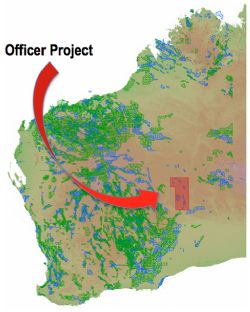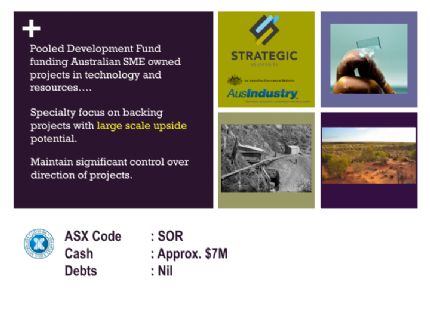 Targets WA Desert in Frontier Copper Hunt
Targets WA Desert in Frontier Copper Hunt
Perth, May 14, 2015 AEST (ABN Newswire) - ASX Listed Pooled Development Fund Strategic Elements ( ASX:SOR) will fund a major copper hunt targeting rocks sticking out of the sand in the deserts of Western Australia, long ignored for their mineral potential. By applying an overseas model the Company recognised that certain areas of 'Permian' rocks in the Great Victoria and Gibson deserts have excellent potential for a style of copper more commonly known in Germany and Poland.
ASX:SOR) will fund a major copper hunt targeting rocks sticking out of the sand in the deserts of Western Australia, long ignored for their mineral potential. By applying an overseas model the Company recognised that certain areas of 'Permian' rocks in the Great Victoria and Gibson deserts have excellent potential for a style of copper more commonly known in Germany and Poland.
After reviewing the limited exploration within a 54,000km2 area the Company discovered highly anomalous copper in several historic drill holes drilled 8km apart, which confirmed the Company's position and provides a clear exploration focus.
The 700 km2 Officer Project is the first project developed in collaboration with world leading geologist Dr Franco Pirajno, who was formerly with the Geological Survey of Western Australia for 21 years, previously an Exploration Manager for Anglo American Corporation (NZ, SW Pacific) and has been involved with several copper discoveries. The Officer Basin has been mapped by the Geological Survey of Western Australia but has limited exploration.
The Officer Project
The Officer Basin has extensive areas of Permian age (approx. 290-250 million years ago) shale and sandstone rocks at surface. The general consensus to date has been that Permian age rocks in WA are economically uninteresting for base metals and hence the Officer Basin has remained overlooked and misunderstood.
However, in collaboration with Dr Franco Pirajno the Permian Kupferschiefer (PKS) copper-silver-cobalt model was applied to the geology of the Officer Basin and the previously unrecognised potential became patently clear.
PKS are a style of deposit in Permian rocks more commonly known in Poland and Germany, are the 2nd most important copper deposits in the world and have an average of 44mt @ 1.8% Cu(1). In PKS copper - silver - cobalt occur as disseminated sulphides in shale and sandstone as well the underlying volcanic rocks.
Evidence in Drill Holes
The Company reviewed all known reports on mineral and petroleum exploration of the Officer Basin. The 54,000km2 of desert surrounding the Officer Project is virtually unexplored. Only four companies have been active in the area. There have only been twenty mineral exploration holes, primarily for diamonds. Significantly however, two of these holes contained highly anomalous copper with all the hallmarks of PKS style mineralisation. These holes are also approx. 8km apart in a north-south direction hinting at the possibility of continuity.
CRA Exploration conducted air core drilling through Permian rocks looking for diamonds in 1988. They didn't find diamonds, however two drill holes contained highly anomalous copper in Permian shale and sandstone rocks.
Mineralisation ranged from surface through to approx. 60m in depth with copper continuing in the underlying volcanic rocks. The geology of the drill holes strongly indicates PKS style copper.
Recognising that the Permian rocks long thought of as just 'cover' were actually a target in their own right led the Company to apply for approx. 700km2 of the most attractive ground, to provide a dominant holding for PKS style mineralisation in the Officer Basin. Research shows that in any mineral district, the largest deposits are usually found first. Gaining first boots on frontier ground for a new model is a significant motivation to the project team.
"All the geological facets needed for Permian Kupfershiefer mineral systems occur in the Officer Basin. It is an exciting project as this type of frontier exploration is not widely done anymore," said Dr Pirajno.
Extensive Areas of Outcrop Available for Sampling
Most deposits have historically been discovered from rocks outcropping at surface. Significantly, the Officer Project includes over 190km of unexplored Permian rocks interpreted to outcrop(2) at the surface. Such a large extent of unexplored outcropping rock means that initial exploration can include low cost and effective mapping and rock sampling activities. In comparison with many other projects that require initial exploration 'under cover', the extent of outcrop that is ready for low cost and effective sampling is a significant advantage of the Project.
Exploration Focus
A value of 4m @1200 ppm Cu was obtained in the top section of the regolith (0-4 m) in CRA drill hole 88WAC8. This value is highly anomalous and it suggests that regolith sampling could be of value for the purpose of targeting in-situ mineralisation. Furthermore, the relatively shallow (10-15 m) overlying regolith material makes it relatively easy for the detection of primary geochemical anomalies.
The Company will focus initial sampling around CRA drill hole 88WAC8 due to the potential to conduct low cost and efficient surface sampling. PKS mineral systems often contain silver and/or cobalt and these elements will also be assayed.
The two CRA drill holes 88WAC8 and 88WAC5 were drilled at sites, which in the Company's structural interpretation could be a pull-apart zone formed by strike-slip, intersected red beds and basaltic rocks. The Company has also conducted some initial interpretation of available geophysics to identify potential structures that may provide pathways for fluids carrying mineralisation (e.g. faults). These areas will also be included in the initial sampling and evaluation programme.
Geochemical analyses showed highly anomalous Cu (850-1000 ppm at depths of 24 to 60 m; hole 88WAC5) and Cu-Mn (730-780 ppm and 980-4000 ppm, respectively, at 56-66 m; hole 88WAC8). The distance between these two holes is 8 km in a N-S direction, hinting at the possibility of continuity.
Explanation of Exploration Strategy
The last major discovery made in Western Australia was the Nova Nickel deposit by Sirius Resources. Just prior to discovery their AGM presentation(3) noted, "several soil anomalies requiring follow up". Within several months the price moved from 5.7c to $2.56(4). It is significant that prior to their nickel discovery, few explorers had thought of targeting the Fraser Range for a magmatic nickel sulphide deposit, an overseas style of deposit known in Canada, but never before seen in Australia.
The Company believes that focusing on a combination of unexplored frontier areas with deposit models more commonly found overseas provides the best chance for making a significant new discovery.
Commodity Mix
The long-term outlook for Copper is positive and the world's largest Copper producers are confident that the next few years will see a return to robust demand growth.
The main growth markets for the metal are the BRIC countries, but demand from Western economies is expected to rise as well. The automotive and aerospace industries are seen as the main catalysts for new growth as manufacturers seek to reduce fuel consumption by creating lighter weight vehicles.
Notes:
1. Sediment Hosted Copper Deposits Model 30b, USGS, 1986
2. Surface Geology of Australia 1:1 million scale dataset 2012 edition
3. Sirius Resources Announcement August 2009
4. Sirius Resources Announcement October 2011
About Strategic Elements Ltd
 Strategic Elements (ASX:SOR) shares are listed on the Australian Stock Exchange under the code “SOR”. The Company is registered under the Pooled Development Program run by the Australian Federal Government to encourage investment into SME’s. To assist Pooled Development Fund’s to invest and raise capital, the Federal Government enables most shareholders in a Pooled Development Fund to make capital gains and receive dividends tax-free.
Strategic Elements (ASX:SOR) shares are listed on the Australian Stock Exchange under the code “SOR”. The Company is registered under the Pooled Development Program run by the Australian Federal Government to encourage investment into SME’s. To assist Pooled Development Fund’s to invest and raise capital, the Federal Government enables most shareholders in a Pooled Development Fund to make capital gains and receive dividends tax-free.
![abnnewswire.com]()
Related Companies
Social Media
Share this Article

 ASX:SOR) will fund a major copper hunt targeting rocks sticking out of the sand in the deserts of Western Australia, long ignored for their mineral potential. By applying an overseas model the Company recognised that certain areas of 'Permian' rocks in the Great Victoria and Gibson deserts have excellent potential for a style of copper more commonly known in Germany and Poland.
ASX:SOR) will fund a major copper hunt targeting rocks sticking out of the sand in the deserts of Western Australia, long ignored for their mineral potential. By applying an overseas model the Company recognised that certain areas of 'Permian' rocks in the Great Victoria and Gibson deserts have excellent potential for a style of copper more commonly known in Germany and Poland. Strategic Elements (ASX:SOR) shares are listed on the Australian Stock Exchange under the code “SOR”. The Company is registered under the Pooled Development Program run by the Australian Federal Government to encourage investment into SME’s. To assist Pooled Development Fund’s to invest and raise capital, the Federal Government enables most shareholders in a Pooled Development Fund to make capital gains and receive dividends tax-free.
Strategic Elements (ASX:SOR) shares are listed on the Australian Stock Exchange under the code “SOR”. The Company is registered under the Pooled Development Program run by the Australian Federal Government to encourage investment into SME’s. To assist Pooled Development Fund’s to invest and raise capital, the Federal Government enables most shareholders in a Pooled Development Fund to make capital gains and receive dividends tax-free.









